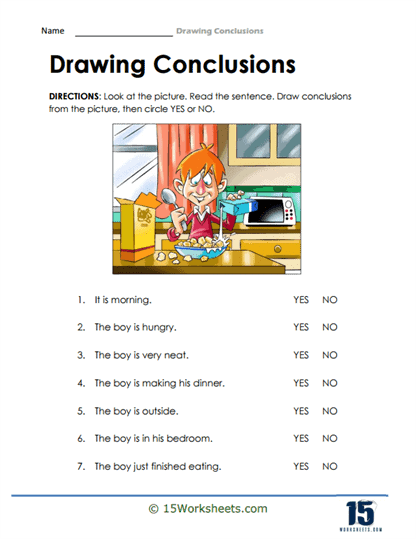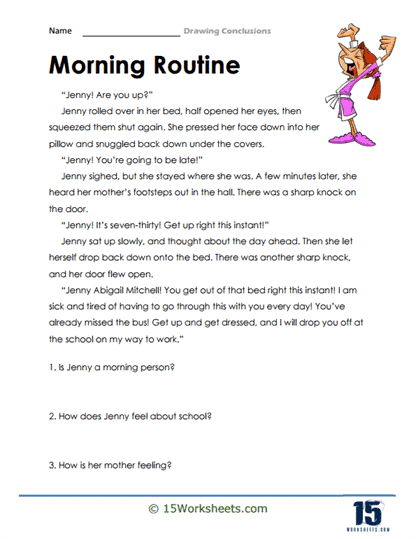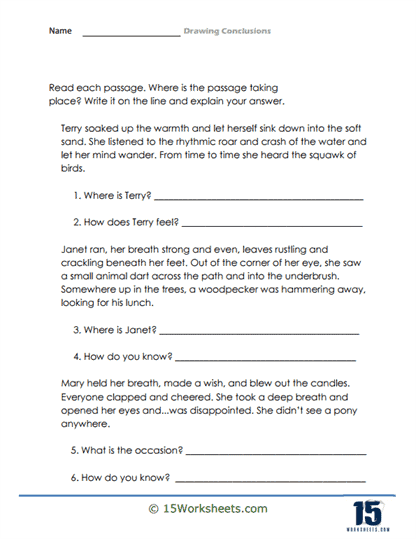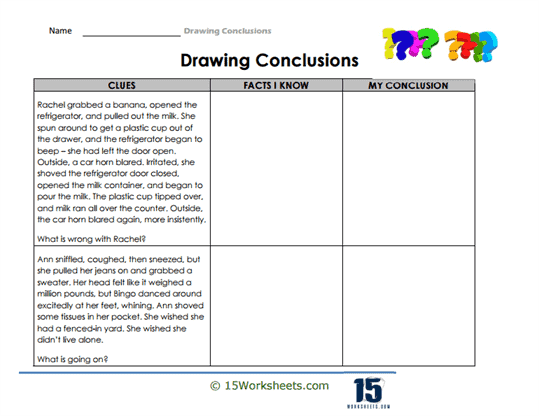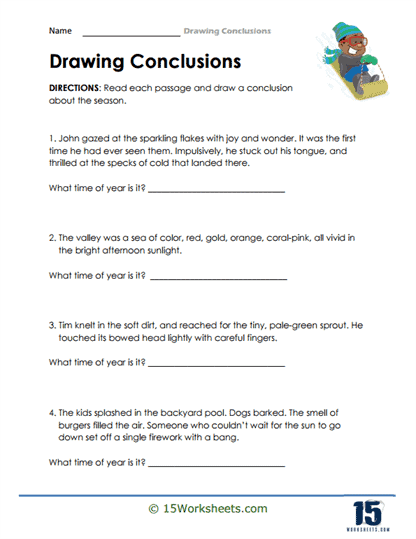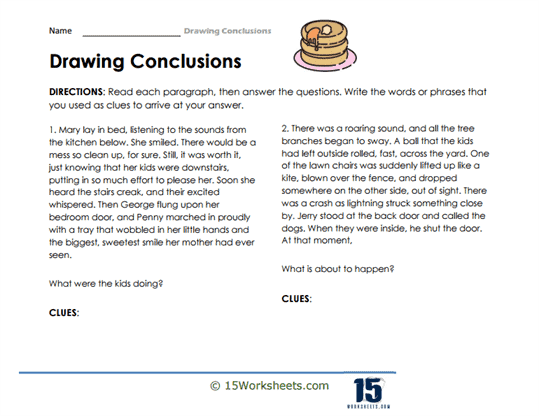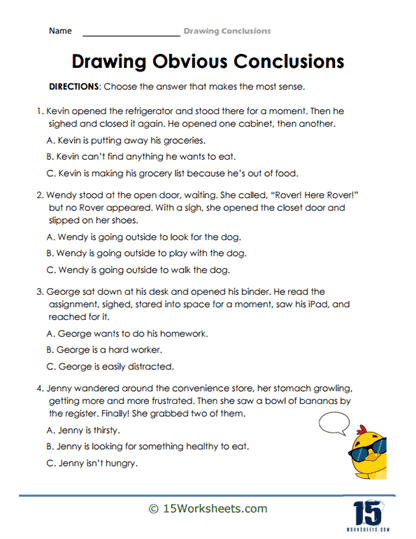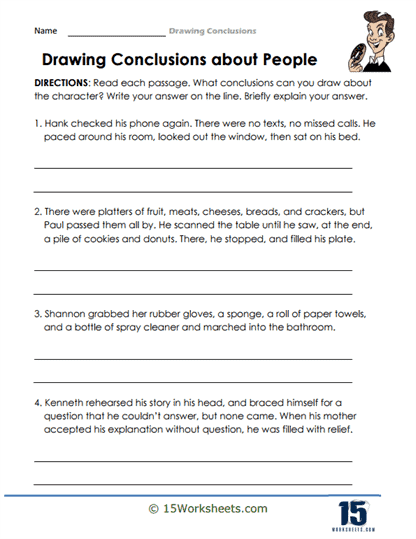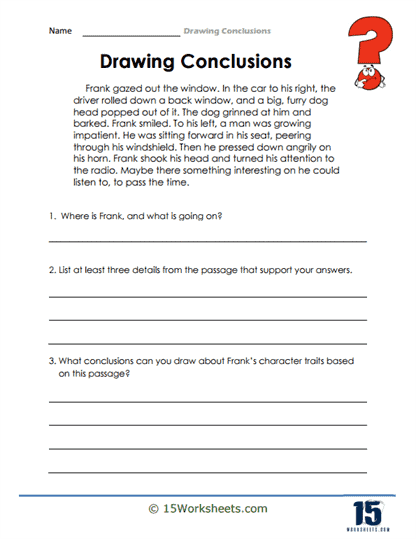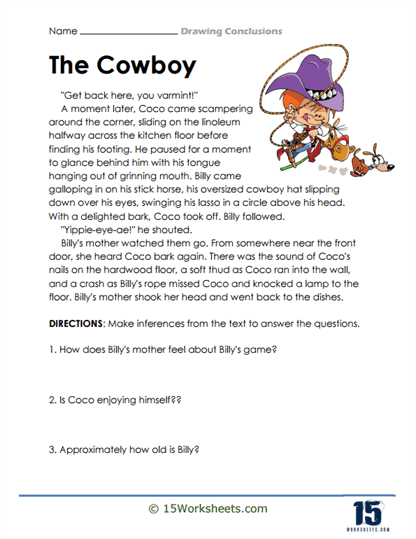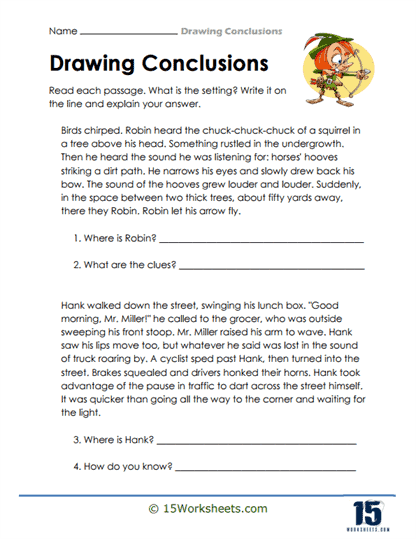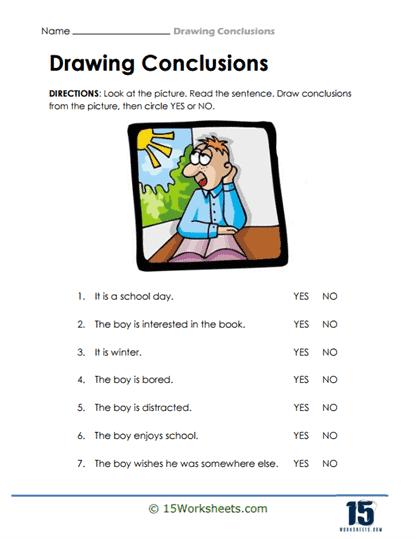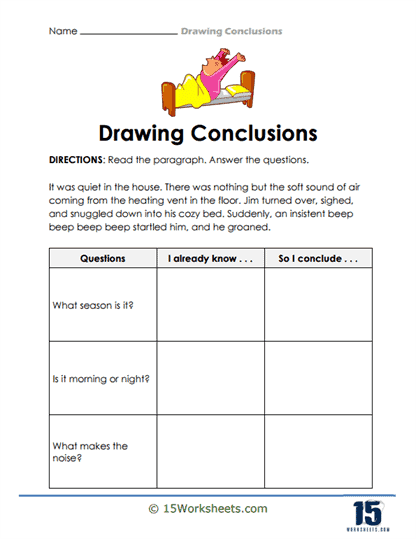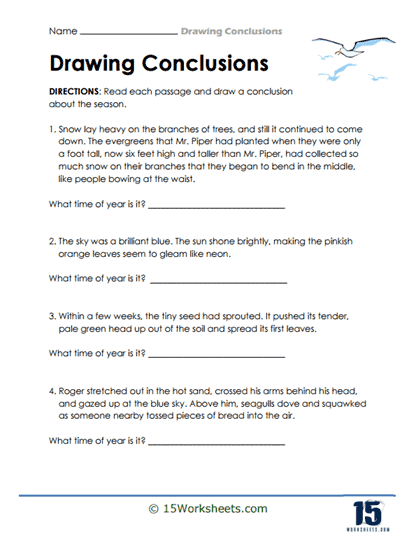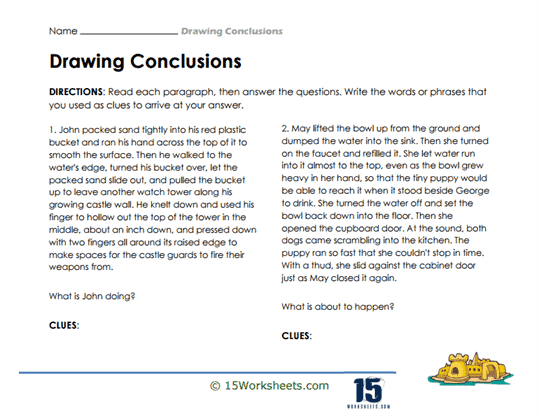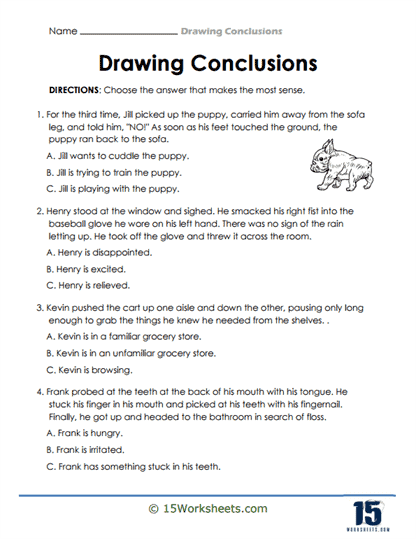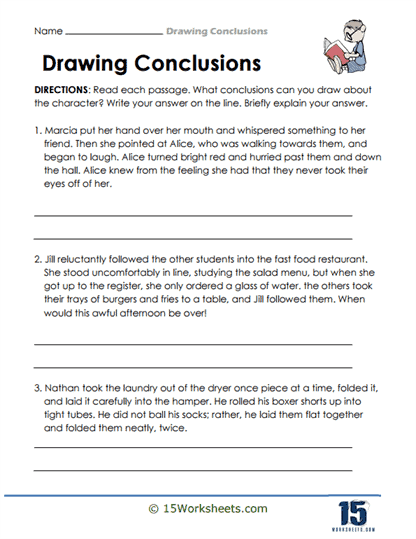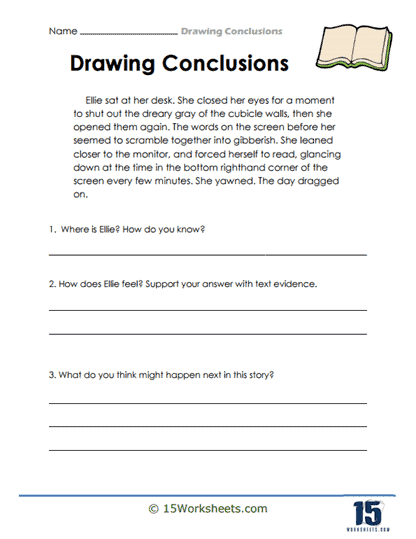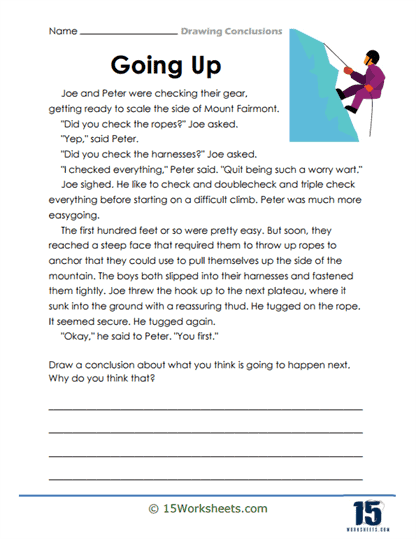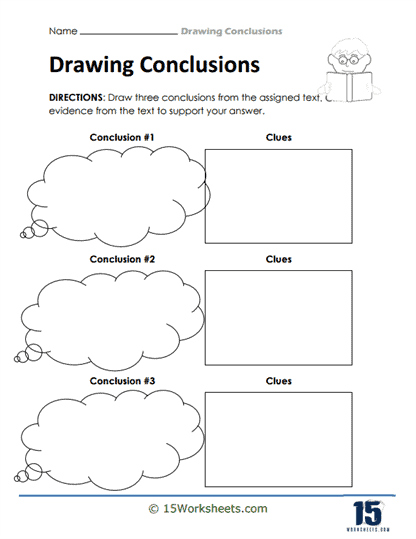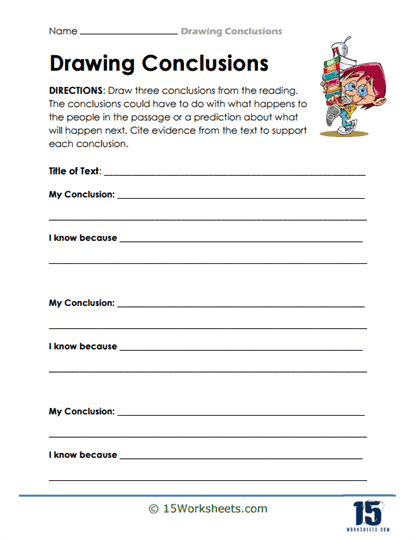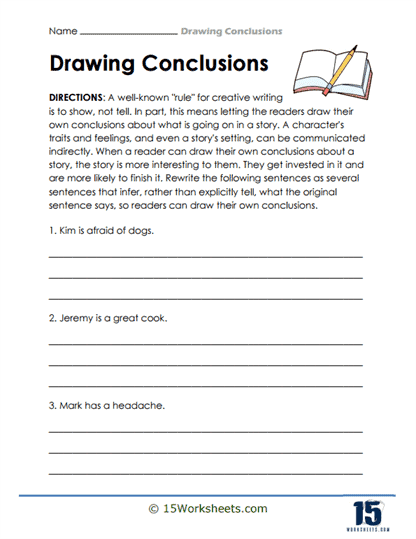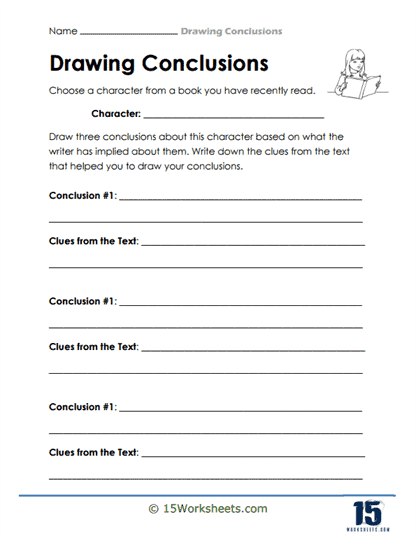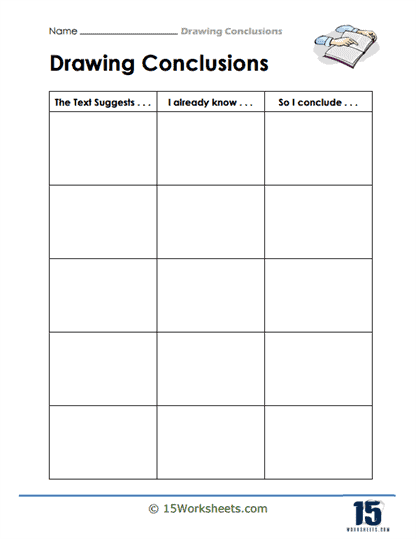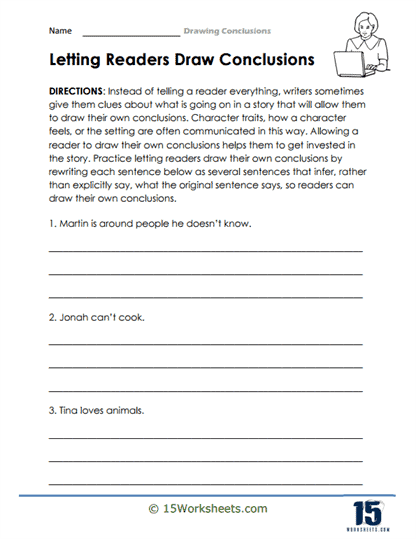Drawing Conclusions Worksheets
All About These Worksheets
The collection of worksheets will help students develop critical thinking skills through inference and observation. These worksheets encourage students to analyze visual and textual clues to draw conclusions, interpret situations, and make reasonable predictions about what is happening or what might happen next. Below is an overview of the skills being targeted across these activities.
The primary skill being developed through these worksheets is the ability to make inferences. Students are presented with pictures, short texts, and scenarios where they must draw conclusions based on what they see or read. This involves piecing together contextual information-visual cues, character behavior, or setting descriptions-and using them to make reasonable assumptions about the situation. These activities hone the students’ ability to interpret incomplete information and predict outcomes, which is crucial for higher-level comprehension in reading and everyday problem-solving.
The worksheets include both narrative passages and picture-based prompts that require students to read closely and infer deeper meanings. This helps strengthen their reading comprehension by requiring them to go beyond surface-level understanding. Instead of merely identifying facts, students must assess the tone, motivation, or unspoken elements of a situation. By practicing this skill, students enhance their ability to comprehend not just literal content but implied ideas and themes in various texts.
In several exercises, students are exposed to varied vocabulary and everyday situations. Through analyzing text passages, they can practice understanding words in context, a critical reading skill. Additionally, students are asked to explain their reasoning or conclusions, either verbally or in written form, which enhances their expressive language abilities. The worksheets also promote engagement with common phrases or expressions that describe emotions, actions, or settings.
A key component of some worksheets is interpreting visual clues. Students must look at pictures, note details like the time of day, character expressions, and objects in the background, and use these details to make logical conclusions. This develops their ability to “read” images-an important skill in a world where visual information is as common as written text. The exercises train students to observe carefully, recognizing small but significant details that can change the interpretation of a scene or narrative.
A Look At These Worksheets
Students get to play judge, jury, and clue-collector across a broad landscape of scenarios. The early worksheets – Yes Or No, Jenny’s Morning Routine, and Setting Detective – serve as the training wheels of inference. These are the gentle introductions, coaxing students into making decisions with limited information. It’s like playing Clue, but instead of Colonel Mustard in the library with a candlestick, it’s Jenny brushing her teeth and students having to decide if she’s late for school based on whether she had toast or cereal. Who knew breakfast could be a crime scene?
Once kids are warmed up, the worksheets start throwing curveballs like a pitcher with a philosophy degree. Worksheets like Magnifying The Clues, Clues To Conclusions, Picking A-B-C, and Inferring Frank bring out the inner Sherlock in every student. These exercises demand students sort through multiple hints and details to select the best conclusion – often choosing between three options that are all mostly right but only one that’s spot-on. It’s the literary version of trying to choose between three brands of spaghetti sauce at the grocery store: they all say “homemade,” but only one doesn’t taste like disappointment.
Then come the contextual chameleons – worksheets that mess with time, place, and setting to push deeper inference muscles. Enter the likes of What Season Is It?, Unlocking The Time Of Year, Billy And Coco, Scene Sleuth, The Beeping Sound, and Picture It. These demand a fusion of clues – like weather patterns, character behavior, and environmental hints – to determine things as sneaky as the month, the location, or what that mysterious “beep” really means. One worksheet might have a character wearing mittens and scraping ice off a windshield, and the student must resist the urge to scream, “It’s December!” without checking for one rogue clue that says they’re in the Southern Hemisphere.
Then the worksheets get deep – we’re talking philosophical inference. The worksheets in this zone – Discovering The Implied, Choosing The Right Fit, Characterization Revelation, Getting Into Context, and Evidential Insights – practically whisper, “Look beyond what’s said.” These prompt students to understand tone, personality, and subtext. It’s the educational equivalent of watching a dramatic film and realizing the character isn’t just staring into the rain – he’s battling generational trauma while waiting for Uber Eats. Students get to make judgments about character motivations, personality traits, and the unsaid thoughts lurking between the lines.
For the grandmasters of drawing conclusions, the worksheets transform into mental triathlons. Think Making Deductions, Make Them Wonder, Beyond The Surface, The Process Of Presumption, From Explicit To Implicit, Back It Up With Proof, Persona Sketch, Deconstructing What You Know, Factual Foundations, and Anticipate The Next Thing. These require evidence-based reasoning, analysis of indirect meaning, and future prediction – all skills that could land students a gig as the next big courtroom drama protagonist. If you’ve ever wanted your students to argue a case using text-based evidence with the intensity of a caffeinated debate team, these are your golden tickets.
How to Draw a Conclusion About What You Read
Drawing a conclusion about a reading passage requires careful analysis, critical thinking, and synthesis of information. Here are some steps to help you effectively draw a conclusion:
Read the passage carefully: Thoroughly read and understand the passage, taking note of important details, themes, and arguments. Make sure to comprehend the author’s main points and purpose.
Identify the main idea: Determine the central theme or message of the passage. This can usually be found in the thesis statement, topic sentences, or in recurring ideas throughout the text.
Look for supporting evidence: Examine the evidence, examples, and arguments the author provides to support their main idea. This can include data, anecdotes, quotes, or expert opinions.
Consider the author’s tone and perspective: Analyze the author’s tone and perspective, considering whether they are objective, subjective, persuasive, or informative. This can provide insights into the author’s intentions and help you better understand their conclusion.
Examine the structure and organization: Evaluate how the passage is structured and organized. Look for logical connections, transitions, and coherence between ideas, which can indicate a well-reasoned argument or conclusion.
Make connections: Connect the information presented in the passage to your prior knowledge or other relevant sources. This can help you identify patterns, similarities, or differences that may be significant to the conclusion.
Synthesize the information: Summarize the main points and evidence, and consider how they relate to each other. This synthesis will help you draw a well-informed conclusion.
Formulate your conclusion: Based on your analysis and synthesis, formulate a conclusion that reflects the main idea, evidence, and overall message of the passage. Your conclusion should be concise, clear, and supported by the text.
Reevaluate and refine: Revisit your conclusion to ensure it is accurate and supported by the passage. Consider alternative interpretations or viewpoints, and refine your conclusion if necessary.
By following these steps, you can effectively draw a conclusion about a reading passage, demonstrating a deep understanding of the text and its purpose.

